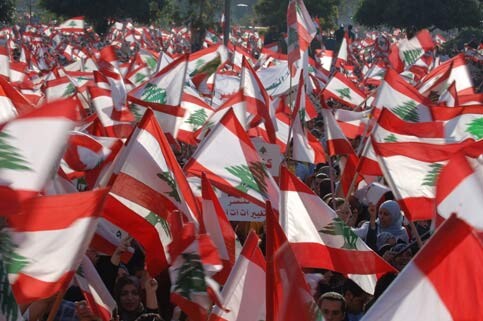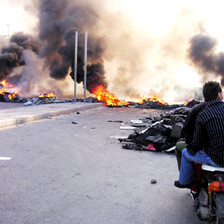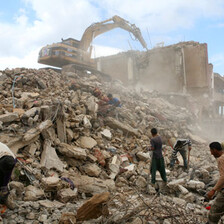IPS 31 December 2006

Hundreds of thousands of opposition supporters wave Lebanese flags during a demonstration in a bid to bring down the government, Beirut, 1 December 2006. (Dina Debbas/IRIN)
The 34-day war between Israel and Hezbollah has left Lebanon heavily damaged and politically destabilised, with hopes for a better future only dimming as the New Year approaches.
Before Jul. 12 this year when the war broke out, many people in this nation of four million situated north of Israel believed they were finally shaking away the last of the dust from the 15-year civil war 1975-90 which decimated the country. That civil war was fought between extreme Muslim and Christian groups. Lebanon is now believed to be about 60 percent Muslim.
In years of recovery from that civil war, tourism was up, business was finally improving, Syrian occupation troops had left - even though it was after the assassination of former prime minister Rafiq Hariri Feb. 14 last year — and hope for a united Lebanon seemed at least a possibility.
All this changed dramatically after a Hezbollah paramilitary raid this summer in which two Israeli soldiers were captured and three others killed near the Israel border. The attack was similar to other clashes along the heated border between the two countries, but this raid provoked a devastating response from the Israeli military.
Less than 24 hours after the Israeli soldiers were captured, the Israeli military bombed Beirut’s Rafik Hariri international airport, enforced a punishing air and naval blockade, and began massive aerial bombardments across much of the country.
Israel’s chief of staff Dan Halutz told reporters at the beginning of the war: “If the soldiers are not returned, we will turn Lebanon’s clock back 20 years.” Halutz made good on his promise.
Hezbollah leader Sayed Hassan Nasralla had planned to use the captured Israeli soldiers as bargaining chips to free some of the thousands of Lebanese and Palestinian prisoners held in Israeli jails. But Israeli Prime Minister Ehud Olmert declared the Hezbollah raid an “act of war” and responded with an all-out attack on Hezbollah positions that destroyed much of capital Beirut and other cities.
By the time a ceasefire was implemented on Aug. 14, 1,200 Lebanese civilians had been killed and another 4,500 wounded. About 250 Hezbollah fighters were killed. A third of the Lebanese civilians killed were children below 13 years of age.
On the Israeli side, 43 civilians were killed and another 1,350 were wounded. The Israeli military lost 119 soldiers, with more than 400 injured.
More than a million Lebanese and as many as 300,000 Israelis were displaced from their homes, and normal life ceased to exist across all of Lebanon and most of northern Israel.
The war dragged on with diplomatic support for Israel from the governments of the United States and Britain. According to a poll taken two weeks into the war, only 8 percent of the Lebanese felt they had support from the U.S.; 87 percent said they supported Hezbollah.
By the time the UN-brokered ceasefire went into effect, a move which finally led Israel to lift its naval blockade of Lebanon Sep. 8, much of the country’s civilian infrastructure had been destroyed.
About 70 bridges and 94 roads were destroyed, along with all major ports. Electrical power plants, 20 gas and fuel stations, 350 schools, food factories, dams, churches, mosques, hospitals, ambulances and a UN base were bombed, according to the UN and the government of Lebanon.
Israel’s air force flew over 12,000 combat missions, its navy fired 2,500 shells, and the army fired more than 100,000 shells. On Jul. 26 Israeli forces destroyed a UN observer post. Israel later described the attack as an accident, though UN officials made repeated calls to alert Israeli forces of the danger to the UN observers, all four of whom were killed. Rescuers who then attempted to reach the post were shelled.
About 15,000 civilian homes were destroyed; the estimated cost of infrastructure damage exceeded 15 billion dollars, according to the United Nations Development Programme (UNDP).
Air strikes on oil tanks on the coast led to spillage of 10,000 tons of heavy oil that polluted 80km of Lebanon’s coast, destroying the fishing and tourism industry.
The Israeli military later admitted to using banned weapons such as white phosphorous and cluster bombs. To date, much of southern Lebanon remains uninhabitable due to unexploded cluster bombs. As of Dec. 1, a quarter of a million Lebanese remain internally displaced as refugees within their own country.
Hezbollah in turn launched thousands of rockets into northern Israel, and engaged invading Israeli soldiers in a guerilla war in southern Lebanon. Over 4,000 rockets fired into Northern Israel killed scores of civilians, and damaged homes and businesses, forcing people to live in underground bomb shelters for days on end.
War crimes were committed by both sides, with indiscriminate attacks in civilian areas.
UN Resolution 1701 was approved Aug. 11, calling for Israeli withdrawal from Lebanon, for Hezbollah to disarm and for a more effective UN force in southern Lebanon. Hezbollah, however, has not disarmed.
Lebanese Prime Minister Fouad Siniora, head of a fractured and largely impotent government, is now facing a crisis as Hezbollah withdrew its ministers from government positions following demands for a “unity” government free from “western influence.”
Having emerged from the war with claims that it is the victor, the group has flexed its newfound political muscle in making these demands to pressure what it sees as a U.S.-backed government.
A southern Beirut victory demonstration late September brought over a million supporters on the streets - a quarter of the entire population of Lebanon. The demonstrators later reassembled to carry out continuing protests against the Siniora-led government.
Portrayed as sectarian by most western media outlets, or as supporters of a coup attempt engineered by Hezbollah allies Iran and Syria, the demonstrators are really Lebanon’s poor and disenfranchised, mostly the Shia community. They are seeking a government that gives them both representation and basic services.
Hezbollah, now in a position to provide these demands more than ever following the war, promises to deliver.
As forces outside Lebanon continue to influence internal politics, the people in Lebanon seem caught in the middle once again. But to avoid a sectarian divide this time, Hezbollah has allied itself with Michel Aoun, a Maronite Christian politician who promises to “clean up” the corrupt Lebanese government.
Unless the Siniora government makes large concessions to include the massive and growing power of Hezbollah and its followers, instability in Lebanon could build up in 2007.
Dahr Jamail reported the Lebanon war and its consequences extensively for IPS. All rights reserved, IPS – Inter Press Service (2006). Total or partial publication, retransmission or sale forbidden.
Related Links





